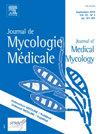Cerebellar abscess caused by Cladophialophora bantiana involving an elderly Japanese woman
IF 1.8
4区 医学
Q3 MYCOLOGY
引用次数: 0
Abstract
Phaeohyphomycosis is a rare fungal infection that presents significant challenges in diagnosis and treatment. Herein, we document a case of a cerebellar abscess caused by Cladophialophora bantiana. A 77-year-old woman with type 2 diabetes mellitus and a previous history of diffuse large B-cell lymphoma gradually developed ataxia and was transferred to an emergency department. Head imaging investigations indicated a cerebellar mass and the patient underwent an emergent endoscopic drainage. Although bacterial cultures of the drainage specimen yielded no growth, a dematiaceous fungus was isolated and subsequently identified as C. bantiana through ITS sequencing analysis. The patient received antifungal combination therapy, initially with liposomal amphotericin B and voriconazole, and finally posaconazole and 5-fluorocytosine. Brain abscesses caused by C. bantiana are rarely documented, and an optimal treatment strategy has yet to be established. Given the high fatality rate, an early surgical intervention is crucial for both diagnosis and treatment. The present case was successfully treated with minimally invasive surgical intervention alongside the antifungal combination therapy.
一名日本老年妇女因小脑脓肿引起
褐丝菌病是一种罕见的真菌感染,在诊断和治疗方面提出了重大挑战。在此,我们记录了一例小脑脓肿引起的Cladophialophora bantiana。77岁女性,2型糖尿病,既往有弥漫性大b细胞淋巴瘤病史,逐渐出现共济失调,转至急诊科。头部影像学检查显示小脑肿块,患者接受紧急内镜引流。虽然细菌培养的排水标本没有生长,但分离出一种真菌,随后通过ITS测序分析确定为C. bantiana。患者接受抗真菌联合治疗,最初使用两性霉素B和伏立康唑脂质体,最后使用泊沙康唑和5-氟胞嘧啶。由C. bantiana引起的脑脓肿很少有文献记载,最佳的治疗策略尚未建立。鉴于高致死率,早期手术干预对诊断和治疗都至关重要。本病例成功地治疗了微创手术干预和抗真菌联合治疗。
本文章由计算机程序翻译,如有差异,请以英文原文为准。
求助全文
约1分钟内获得全文
求助全文
来源期刊
CiteScore
5.10
自引率
2.80%
发文量
68
审稿时长
6-12 weeks
期刊介绍:
The Journal de Mycologie Medicale / Journal of Medical Mycology (JMM) publishes in English works dealing with human and animal mycology. The subjects treated are focused in particular on clinical, diagnostic, epidemiological, immunological, medical, pathological, preventive or therapeutic aspects of mycoses. Also covered are basic aspects linked primarily with morphology (electronic and photonic microscopy), physiology, biochemistry, cellular and molecular biology, immunochemistry, genetics, taxonomy or phylogeny of pathogenic or opportunistic fungi and actinomycetes in humans or animals. Studies of natural products showing inhibitory activity against pathogenic fungi cannot be considered without chemical characterization and identification of the compounds responsible for the inhibitory activity.
JMM publishes (guest) editorials, original articles, reviews (and minireviews), case reports, technical notes, letters to the editor and information. Only clinical cases with real originality (new species, new clinical present action, new geographical localization, etc.), and fully documented (identification methods, results, etc.), will be considered.
Under no circumstances does the journal guarantee publication before the editorial board makes its final decision.
The journal is indexed in the main international databases and is accessible worldwide through the ScienceDirect and ClinicalKey platforms.

 求助内容:
求助内容: 应助结果提醒方式:
应助结果提醒方式:


